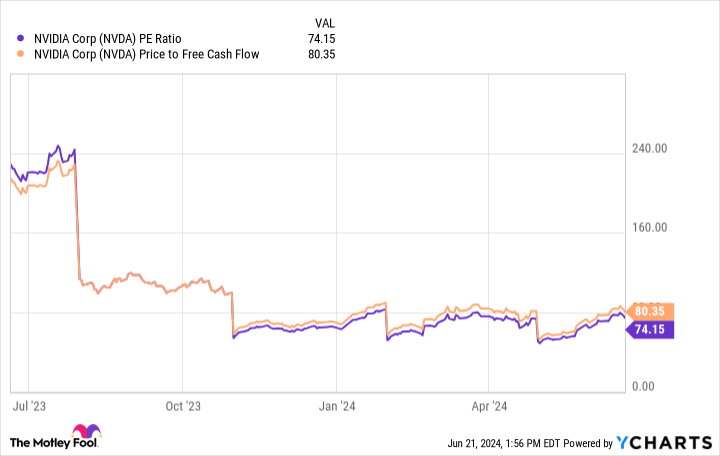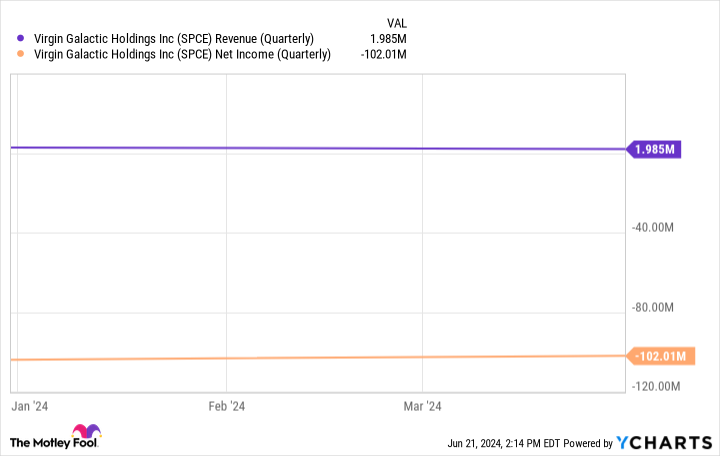Only six months into 2024, investors have gotten a front row seat to a number of stock splits. Walmart completed a split earlier this year, while Chipotle shareholders recently approved a 50-for-1 split set to occur very soon.
Among prominent stock-split stocks, two in particular stick out. Semiconductor behemoth Nvidia (NASDAQ: NVDA) recently completed a 10-for-1 split in early June. Around the same time, Virgin Galactic (NYSE: SPCE) executed a 1-for-20 reverse stock split.
Let’s explore which of these companies looks like a terrific opportunity for long-term shareholders and which one investors are best off avoiding.
1. The stock-split stock to buy and hold for decades: Nvidia
I’d argue that Nvidia is the hottest stock in the market right now. The company has earned widespread praise from retail and institutional investors alike thanks to the company’s impressive momentum in the artificial intelligence (AI) market.
As the chart above illustrates, Nvidia’s financial profile was relatively steady — if not somewhat mundane — for nearly a decade. However, as interest in AI started to become more mainstream over the last 18 months or so, Nvidia’s business experienced an abnormally bullish influx.
Nvidia specializes in graphics processing units (GPU) and data center services — each of which plays an important role in the development of generative AI applications. Unsurprisingly, as Nvidia’s business has ballooned, so has its stock price.
In fact, after soaring over 150% so far in 2024, Nvidia briefly dethroned Microsoft as the world’s most valuable company as measured by market cap. Despite this rapid ascent, I still see Nvidia as a reasonable buying opportunity.
The company’s price-to-earnings (P/E) ratio of 74 and price-to-free-cash-flow (P/FCF) multiple of 80 are pretty pricey, even for a growth stock. However, the trends in the chart above shed light on an interesting dynamic.
Both of these profitability valuation multiples are lower than they were a year ago. The reason for this is that Nvidia is expanding its profits at a faster rate than its revenue.
Considering that AI is still in its early innings and that Nvidia is showing the ability to accelerate its cash flow generation while also witnessing record revenue growth, I think the stock is a no-brainer for long-term investors.
2. The stock-split stock to avoid like the plague: Virgin Galactic
Virgin Galactic is a space exploration business listed on the New York Stock Exchange (NYSE). One of the requirements to be listed on the NYSE is to maintain a minimum stock price.
If a company fails to maintain this criteria, it can become at risk of being delisted. Unfortunately, this is the case for Virgin Galactic.
During a reverse stock split, a company reduces its outstanding share count, which inherently pushes the stock price higher.
In the case of Virgin Galactic, the company’s share count was reduced (divided) by a factor of 20 while its share price rose (multiplied) by that same multiple. When the reverse split took effect on June 17, the stock opened at around $10 per share. However, this means that the stock was trading near $0.50 before the split — well below the requirements to remain in good standing on the NYSE.
In reality, Virgin Galactic should be seen as a penny stock. Furthermore, I think the business is upside down.
In the chart above, investors can see that so far this year, the company has generated a measly $2 million in revenue. However, it spent over $100 million to get there — resulting in mammoth operating losses.
Space exploration is a highly competitive industry that includes juggernauts such as Elon Musk’s SpaceX and Jeff Bezos’s Blue Origin, as well as a number of government contractors. On top of that, it’s an incredibly sophisticated product offering that requires hefty expenses in research and development and capital expenditures (capex).

The bottom line
Like Virgin Galactic, Nvidia also faces its share of competition. The main difference I see between Nvidia and Virgin Galactic is that one business sells a product that’s in demand, and the other does not.
I think AI is here to stay in some form or fashion for the long haul. For that reason, Nvidia should continue to witness demand for its products across the AI spectrum.
On the contrary, space exploration is an incredibly niche market. Very few people can afford a commercial trip to outer space, and I’d wager that even fewer would be comfortable even giving it a try.
At the end of the day, I think Virgin Galactic is a high-cash-burn business with little in the way of promising business prospects. I think it’s a speculative investment at best, and should likely be avoided.
On the other hand, Nvidia is not only benefiting from AI but the stock looks reasonably valued and very well appears to have room to run over many years.
Should you invest $1,000 in Nvidia right now?
Before you buy stock in Nvidia, consider this:
The Motley Fool Stock Advisor analyst team just identified what they believe are the 10 best stocks for investors to buy now… and Nvidia wasn’t one of them. The 10 stocks that made the cut could produce monster returns in the coming years.
Consider when Nvidia made this list on April 15, 2005… if you invested $1,000 at the time of our recommendation, you’d have $772,627!*
Stock Advisor provides investors with an easy-to-follow blueprint for success, including guidance on building a portfolio, regular updates from analysts, and two new stock picks each month. The Stock Advisor service has more than quadrupled the return of S&P 500 since 2002*.
*Stock Advisor returns as of June 24, 2024
Adam Spatacco has positions in Microsoft and Nvidia. The Motley Fool has positions in and recommends Chipotle Mexican Grill, Microsoft, Nvidia, and Walmart. The Motley Fool recommends the following options: long January 2026 $395 calls on Microsoft and short January 2026 $405 calls on Microsoft. The Motley Fool has a disclosure policy.
1 Stock Split Stock to Buy and Hold for Decades, and 1 to Avoid Like the Plague was originally published by The Motley Fool









